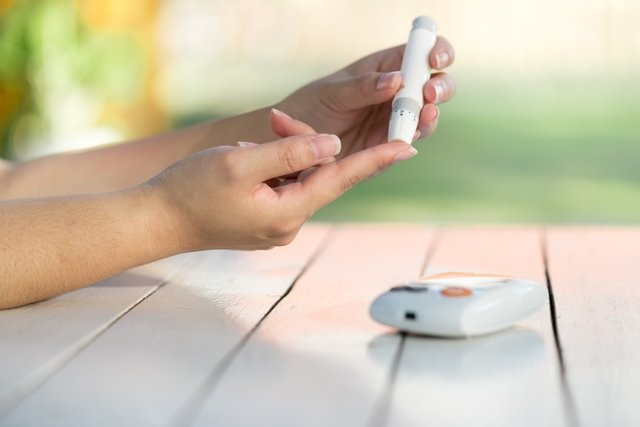Type 1 diabetes is a type of diabetes in which the pancreas produces little or no insulin, causing the body to be unable to use blood sugar, resulting in increased blood glucose and symptoms such as dry mouth, constant thirst and urge to urinate frequently.
Type 1 diabetes is normally related to genetic and autoimmune factors, in which the immune system attacks and destroys the cells in the pancreas responsible for producing insulin. Therefore, there is not enough insulin produced to cause glucose to enter the cells, remaining in the bloodstream.
The treatment of type 1 diabetes, also known as juvenile diabetes or insulin-dependent diabetes, is carried out by an endocrinologist or pediatrician, using insulin applied under the skin to control symptoms and prevent complications. of the person’s life.

Symptoms of type 1 diabetes
The main causes of type 1 diabetes are:
- Feeling of constant thirst;
- Frequent urge to urinate;
- Constant hunger;
- Excessive tiredness;
- Weight loss for no apparent reason;
- Difficulty gaining weight;
- Dor abdominal;
- Vomiting;
- Irritability;
- Mood changes;
- Blurry vision;
- Vaginal candidiasis common in girls and women;
- Difficulty healing wounds;
- Difficulty concentrating.
The symptoms of diabetes 1 can appear suddenly and are related to an increase in the amount of glucose circulating in the blood due to poor functioning of the pancreas and lack of insulin.
In the case of children, in addition to these symptoms, some signs may indicate type 1 diabetes, such as starting to wet the bed again at night or having recurrent infections in the intimate area. See how to recognize the first symptoms of diabetes in children.
Furthermore, type 1 diabetes, when not diagnosed and treated properly, can cause diabetic ketoacidosis, which is a serious condition characterized by high blood sugar levels and increased blood acidity, leading to the appearance of other symptoms, such as nausea, vomiting, breath that smells like rotten apples, abdominal pain, shallow and rapid breathing, mental confusion or coma. Understand what diabetic ketoacidosis is and how it is treated.
How to confirm the diagnosis
The diagnosis of type 1 diabetes is made by an endocrinologist through the evaluation of symptoms and blood tests, such as a glycated hemoglobin or Hb1Ac test, which assesses glucose levels in the last two to three months before the test, and/or fasting glucose levels.
This is because blood sugar binds to hemoglobin, which is responsible for bringing oxygen to cells, and the higher the blood sugar levels, the higher the value of glycated hemoglobin. If the result of this test was equal to or greater than 6.5% in two tests carried out at different times, the diagnosis of type 1 diabetes is confirmed by the doctor. See reference values for glycated hemoglobin.
Taking care of your health has never been easier!
In addition, the doctor may order a fasting blood glucose test to analyze the amount of sugar in the blood, a urinalysis test to assess the presence of ketones in the urine, or a test for autoantibodies, which are common in type 1 diabetes.
Measuring blood sugar levels can also be carried out at home, using a glucometer, which allows you to monitor blood glucose levels, especially for people who have a confirmed diagnosis of type 1 diabetes. Learn how to use the glucometer correctly.
Possible causes
The exact cause of type 1 diabetes is not fully known, but it is believed to occur due to genetic and environmental factors, leading to the destruction of the beta cells of the pancreas, due to an attack by the immune system on these cells, as if they were foreign to the body. .
It is believed that environmental factors, especially viral infections, can trigger this autoimmune destruction of pancreatic beta cells in people who are genetically predisposed.
Differences between type 1 and type 2 diabetes
Symptoms in general help to differentiate type 1 diabetes from type 2. In type 1 diabetes, symptoms of total insulin deficiency predominate, such as weight loss, excessive thirst and increased urine volume. In type 2 diabetes, most cases do not present symptoms, and the diagnosis is made through routine examinations.
In type 1 diabetes, there is an autoimmune destruction of the pancreas cells responsible for producing insulin, which causes the disease to begin abruptly due to the absence of insulin in the body. The basis of type 2 diabetes is resistance to the action of insulin in peripheral organs, mainly muscle and adipose tissue, which happens as a consequence of multiple factors involved, such as excess weight, sedentary lifestyle and genetics, for example.
Furthermore, as type 1 diabetes involves the destruction of pancreas cells through genetic changes, there is no prevention and treatment must involve daily insulin injections to regulate blood glucose levels.
On the other hand, as the development of type 2 diabetes is also related to lifestyle habits, it is possible to avoid (in some cases) this type of diabetes through a balanced and healthy diet and regular physical activity. Learn about other differences between types of diabetes.
How the treatment is carried out
The treatment of type 1 diabetes must be carried out with the guidance of an endocrinologist, with the daily use of insulin in the form of an injection under the skin or, in some cases, the use of an insulin pump, in accordance with the doctor’s instructions. Learn about the main types of insulin and how to apply it.
Furthermore, it is recommended that glucose concentration be monitored before and after meals, and it is recommended that glucose levels before meals are, in general, between 70 and 130 mg/dL and after meals below 180 mg. /dL. The HBAIC target is generally less than 7%.
Treatment for type 1 diabetes helps prevent the emergence of complications such as ketoacidosis, vision problems, heart and kidney diseases, for example. See more about treatment for type 1 diabetes.
To complement the treatment of type 1 diabetes, it is important to have a nutritionist specialized in monitoring, who will advise a diet with little or no sugar and low carbohydrate content, such as bread, cake, rice, pasta, cookies and some fruits, for example, and a greater consumption of fiber/whole foods.
Furthermore, practicing physical activities such as walking, running or swimming as advised by your doctor can also help control blood glucose levels.
See what nutrition should be like in type 1 diabetes

Sign up for our newsletter and stay up to date with exclusive news
that can transform your routine!
Warning: Undefined array key "title" in /home/storelat/public_html/wp-content/plugins/link-whisper-premium/templates/frontend/related-posts.php on line 12
Warning: Undefined array key "title_tag" in /home/storelat/public_html/wp-content/plugins/link-whisper-premium/templates/frontend/related-posts.php on line 13



